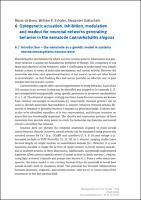Chapter 6 Optogenetic actuation, inhibition, modulation and readout for neuronal networks generating behavior in the nematode Caenorhabditis elegans
Author(s)
de Bono, Mario
Schafer, William R.
Gottschalk, Alexander
Contributor(s)
Hegemann, Peter (editor)
Sigrist, Stephan (editor)
Collection
European Research Council (ERC); EU collectionLanguage
EnglishAbstract
Elucidating the mechanisms by which nervous systems process information and generate behavior is among the fundamental problems of biology. The complexity of our brain and plasticity of our behaviors make it challenging to understand even simple human actions in terms of molecular mechanisms and neural activity. However the molecular machines and operational features of our neural circuits are often found in invertebrates, so that studying flies and worms provides an effective way to gain insights into our nervous system. Caenorhabditis elegans offers special opportunities to study behavior. Each of the 302 neurons in its nervous system can be identified and imaged in live animals [1, 2], and manipulated transgenically using specific promoters or promoter combinations [3, 4, 5, 6]. The chemical synapses and gap junctions made by every neuron are known from electron micrograph reconstruction [1]. Importantly, forward genetics can be used to identify molecules that modulate C. elegans’ behavior. Forward genetic dis-section of behavior is powerful because it requires no prior knowledge. It allows molecules to be identified regardless of in vivo concentration, and focuses attention on genes that are functionally important. The identity and expression patterns of these molecules then provide entry points to study the molecular mechanisms and neural circuits controlling the behavior. Genetics does not provide the temporal resolution required to study neural circuit function directly. However, neural activity can be monitored using genetically encoded sensors for Ca2+ (e.g., GCaMP and cameleon) [7, 8, 9, 10] and voltage (e.g., mermaid, arclight or VSFP- Butterfly) [11, 12, 13]. In C. elegans, imaging studies have focused largely on single neurons in immobilized animals [14]. However, it is now becoming possible to image the activity of single neurons in freely moving animals, and of multiple neurons in three dimensions. Additionally, increasingly sophisticated hardware allows precise spatial control of neural activity in freely moving C. elegans, using light activated channels and pumps (see Section 6.2). From a reductionist perspective, the worm model is very exciting because it has the potential to reveal how neural circuits work in enormous detail. This potential has fostered collaborations between physicists, engineers, and neuroscientists. Here we try to convey some of the excitement in this fast moving field.
Book
OptogeneticsKeywords
Biophysics; Genetic Engineering; Neuroscience; Optics; Vision RestorationDOI
10.1515/9783110270723.61ISBN
9783110270716OCN
1135844905Publisher
De GruyterPublisher website
https://www.degruyter.com/Publication date and place
Berlin/Boston, 2013Grantor
Classification
Biophysics
Genetics (non-medical)
Neurosciences
Human biology


 Download
Download